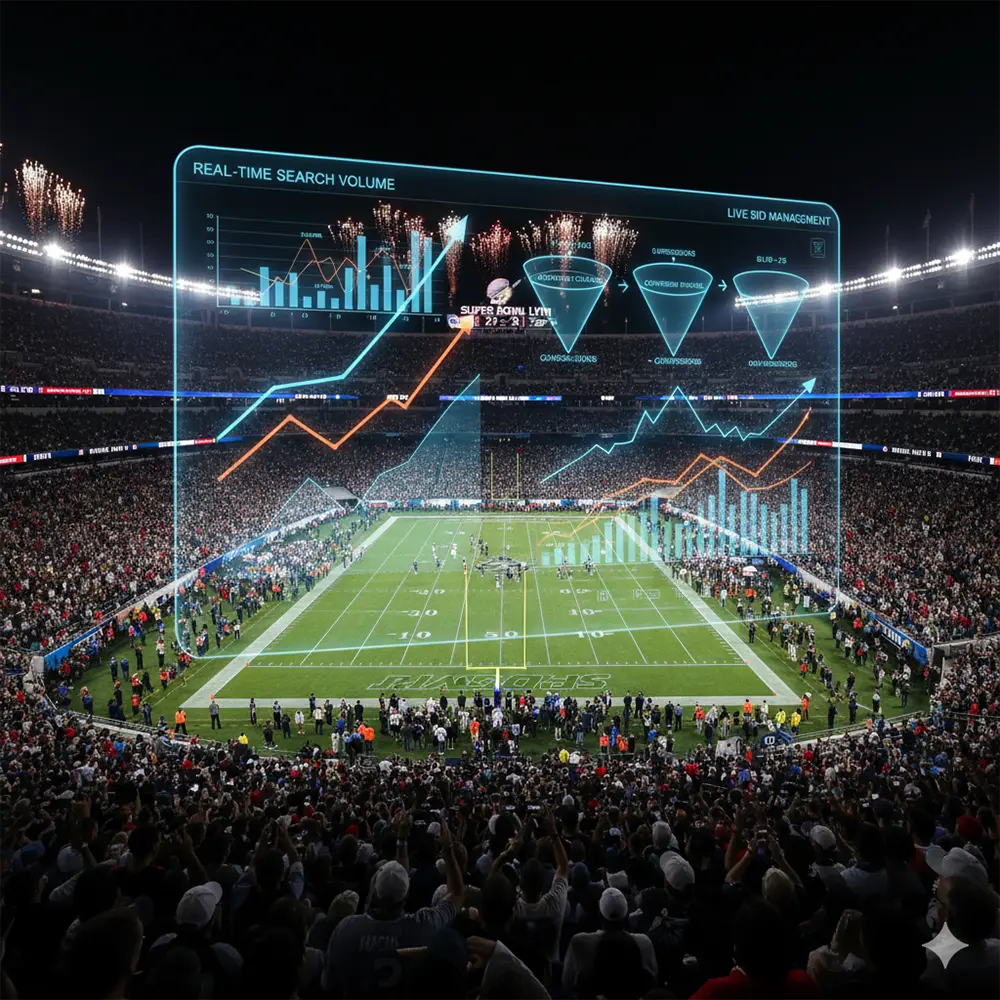
An Editor's Note from 2025
The Super Bowl isn't just America's biggest sporting event; for digital advertisers, it's a digital gold rush. This article, first written in 2015, breaks down how we approached the massive surge in search volume when every brand wanted a piece of the action. It reflects an era of manual, search-focused tactics that laid the groundwork for today's more complex strategies. This updated version preserves that original blueprint and adds critical analysis on how live-event marketing has been completely transformed by real-time technology and AI.
The 2025 Perspective: From Search Queries to Live Conversations
In 2015, a "live event" campaign mostly meant capturing search queries before and after the game. Today, the campaign is a live, breathing entity that engages with the audience *during* the event itself.
- The Second-Screen Revolution:
The biggest change is the ubiquity of the second screen. Viewers are not just watching the game; they are on their phones, searching for player stats, reacting on social media, and re-watching commercials on YouTube. A modern campaign is designed to capture this divided attention.
- From Search Ads to Performance Max:
A 2015 campaign was siloed: Search, Display, and Video were separate. Today, a Performance Max campaign would be the centerpiece, using video assets of the brand's commercial to target audiences across YouTube, Gmail, and the Display Network simultaneously.
- Real-Time Marketing on Social:
The conversation around the Super Bowl happens on platforms like X (formerly Twitter). Modern strategies involve having ad creative ready to launch instantly in reaction to game moments—a key touchdown, a controversial call, or a memorable halftime show performance.
The Modern Super Bowl Playbook: A Phased Assault
A Super Bowl campaign today is a multi-phase operation designed to maximize impact at every stage of the event.
- Phase 1 (Pre-Game Hype):
Two weeks out, campaigns go live to build awareness. The focus is on broad discovery, targeting searches like "best super bowl snacks," "when is the super bowl," and—crucially—"super bowl commercials 2025," as many brands release their ads early online.
- Phase 2 (Game Day Battleground):
This is the real-time digital battleground. Campaigns pivot to high-intent, immediate needs: "pizza delivery near me," "watch super bowl online," and searches for players and halftime performers. Bids are automated to respond to sudden surges in volume.
- Phase 3 (Post-Game Analysis):
For 48 hours after the game, the focus shifts to capturing the post-mortem conversation. Keywords include "super bowl highlights," "funniest commercials," and merchandise searches for the winning team.
The following is the original 2015 playbook. It focuses on a critical, timeless strategy: how non-sponsor brands can leverage the massive halo effect of the Super Bowl to drive their own business goals by capturing the ancillary demand.
The Original 2015 Blueprint: Capturing Ancillary Demand
The Super Bowl is one of the most-watched television programs in America, with the 2014 event recording over 111 million viewers. This presents a massive opportunity for broadcasters and official sponsors, with a 30-second commercial slot costing approximately $4 million. However, for digital advertisers, the event creates a tidal wave of search interest that extends far beyond the game itself.
The strategy for non-sponsor brands was to leverage this seasonal spike to advertise their own products and services. For example, a hotel in the host city (Glendale, AZ for Super Bowl XLIX) would launch a PPC campaign to attract travelers, while food and beverage companies would target searches related to party planning. Historically, dozens of major brands competed for this ancillary search traffic.
Building the Keyword Portfolio
The keyword list was based on trends from previous years, segmented into categories that were relevant to our clients' businesses. For any given client—be it a food delivery service, a merchandise retailer, or a travel agency—we could activate the relevant ad groups to capture the surge in related searches. The primary categories included:
- Food & Party Trends:
Targeting keywords like "super bowl party recipes," "chicken wing delivery," and "best game day snacks."
- Merchandise:
Focusing on searches for team apparel, such as "Patriots jerseys" or "Seahawks hats."
- Tickets & Travel:
High-value keywords for last-minute planners, including "super bowl tickets for sale" and "hotels near university of phoenix stadium."
- General & Commercials:
Capturing broad interest with terms like "super bowl halftime show," "who is playing in the super bowl," and "watch super bowl commercials online."